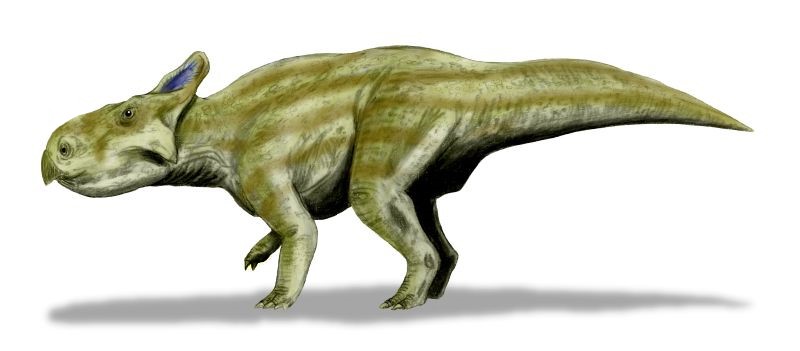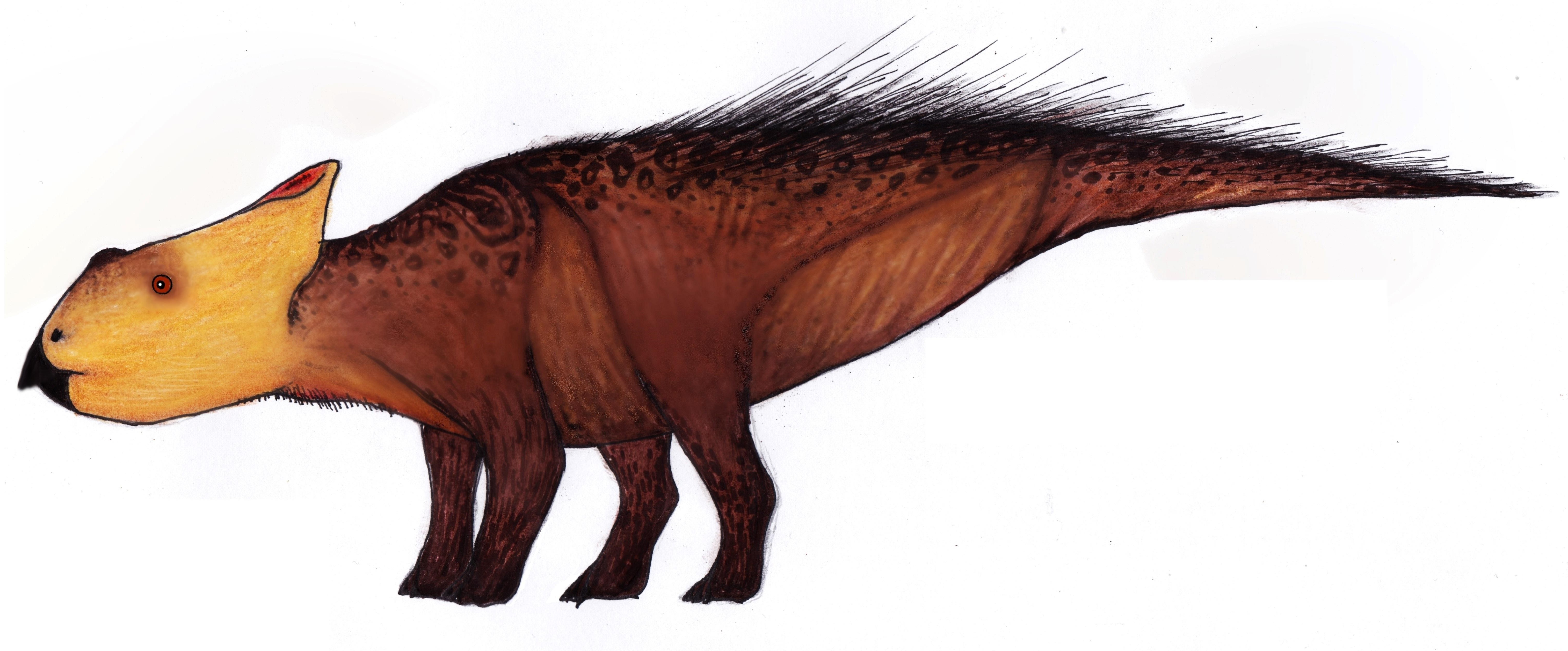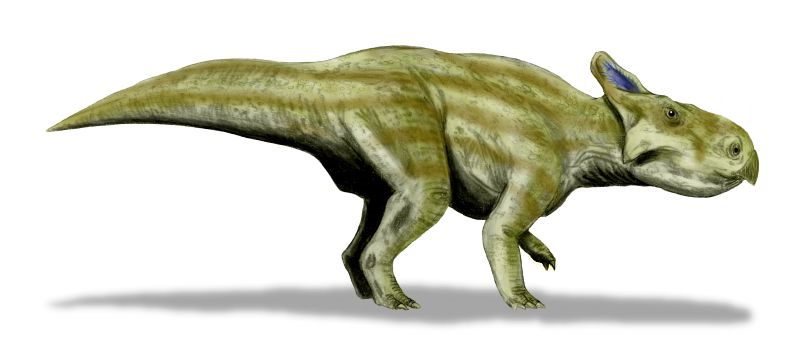|
Leptoceratopsids
Leptoceratopsidae is an extinct family of neoceratopsian dinosaurs from Asia, North America and Europe. Leptoceratopsids resembled, and were closely related to, other neoceratopsians, such as the families Protoceratopsidae and Ceratopsidae, but they were more primitive and generally smaller. Phylogeny Leptoceratopsidae was originally named by Franz Nopcsa von Felső-Szilvás in 1923 as a subfamily Leptoceratopsinae, and its type species is ''Leptoceratops gracilis''. Mackovicky, in 2001, defined it as a stem-based taxon and a family consisting of ''Leptoceratops gracilis'' and all species closer to ''Leptoceratops'' than to ''Triceratops horridus''.Makovicky, P.J. 2001. A ''Montanoceratops cerorhynchus'' (Dinosauria: Ceratopsia) braincase from the Horseshoe Canyon Formation of Alberta, In: Tanke, D.H. & Carpenter, K. (Eds.). ''Mesozoic Vertebrate Life''. Bloomington: Indiana University Press. Pp. 243-262. The cladogram below follows the topologies from a 2015 analysis by Yiming ... [...More Info...] [...Related Items...] OR: [Wikipedia] [Google] [Baidu] |
Zhuchengceratops
''Zhuchengceratops'' is a genus of extinct leptoceratopsid ceratopsian that lived during the Upper Cretaceous of modern-day China. It was first described in 2010, by Xu ''et al.'', who created the binomial ''Zhuchengceratops inexpectus''. The name is derived from the location of Zhucheng, the Latinized-Greek ''ceratops'', or "horned face", and the unexpected articulated nature of the holotype. The skeleton was found in the Wangshi Group, which is of Late Cretaceous age, and most fossils are only disarticulated bones of ''Shantungosaurus''. ''Zhuchengceratops'' shares many features with Leptoceratopsidae as well as other ceratopsian groups such as Ceratopsidae. The overall size of the taxon was similar to ''Leptoceratops'', although slightly larger. ''Zhuchengceratops'' was analyzed to be in a group with ''Leptoceratops'' and ''Udanoceratops'', although internal relationships of this triplet were unresolved. Discovery and naming ''Zhuchengceratops'' is a derived leptoceratopsid ... [...More Info...] [...Related Items...] OR: [Wikipedia] [Google] [Baidu] |
Cerasinops
''Cerasinops'' (meaning 'cherry face') was a small ceratopsian dinosaur. It lived during the Campanian of the late Cretaceous Period. a '''' article; the photographed skeleton is actually from ''''. Its fossils have been found in , in |
Prenoceratops
''Prenoceratops'', (meaning 'bent or prone-horned face' and derived from Greek ''prene-/πρηνη-'' meaning 'bent forwards' or 'prone', ''cerat-/κερατ-'' meaning 'horn' and ''-ops/ωψ'' meaning 'face') is a genus of ceratopsian dinosaur from the Late Cretaceous Period. It was a relatively small dinosaur, reaching in length and in body mass. Its fossils have been found in the upper Two Medicine Formation in the present-day U.S. state of Montana, in Campanian age rock layers that have been dated to 74.3 million years ago.Ryan, M. J., Evans, D. C., Currie, P. J., Brown, C. M., & Brinkman, D. (2012). New leptoceratopsids from the Upper Cretaceous of Alberta, Canada. ''Cretaceous Research'', 35: 69-80. Fossils were also found in the Oldman Formation in the modern day Canadian province of Alberta, dating to around 77 million years ago. Discovery and species ''Prenoceratops'' was first discovered on a Blackfeet reservation in Pondera County, Montana in layers coming from the ... [...More Info...] [...Related Items...] OR: [Wikipedia] [Google] [Baidu] |
Unescoceratops
''Unescoceratops'' is a genus of leptoceratopsid ceratopsian dinosaurs known from the Late Cretaceous of Alberta, southern Canada. It contains a single species, ''Unescoceratops koppelhusae''. Discovery ''Unescoceratops'' is known only from the holotype specimen TMP 95.12.6, a partial left dentary. The fossil was collected in 1995 in the Black Coulee locality (formerly Deadhorse Coulee), near the Writing-on-Stone Provincial Park, from the Dinosaur Park Formation, dating to the late Campanian stage of the Late Cretaceous period, about 76.5-75 million years ago. The specimen was regarded as too incomplete to identify, and was shelved for several years. It was believed to be a ''Leptoceratops'' specimen at the time. A cladistic analysis done by Michael Ryan (of The Cleveland Museum of Natural History) and David Evans (of the Royal Ontario Museum) found it to be among the most advanced leptoceratopsid genera. Description ''Unescoceratops'' is thought to have been between ... [...More Info...] [...Related Items...] OR: [Wikipedia] [Google] [Baidu] |
Udanoceratops
''Udanoceratops'' (meaning "Udan's horned face") is a genus of large leptoceratopsid dinosaur that lived during the Late Cretaceous period of Mongolia, in what is now the Djadokhta Formation. Discovery ''Udanoceratops'' was first named and described by Russian paleontologist Sergei Kurzanov in 1992 and the type species is ''Udanoceratops tschizhovi''. The holotype (PIN 3907/11) was collected during the 1980s at the Udan Sayr (also spelled Udyn Sayr or Üüden Sair) locality of the Djadokhta Formation in Ömnögovi Province, dating to the Campanian stage of the Late Cretaceous period. The generic name is derived from the name of the locality in which the holotype was found (Udan Sayr) and Greek ''ceras/κέρας'' meaning "horn" and ''-ops/ωψ'' meaning "face". ''Udanoceratops'' is best known from the holotype specimen, which represents a large individual comprising a large, relatively well-preserved and almost complete skull, and sparse body remains including vertebrae. In 19 ... [...More Info...] [...Related Items...] OR: [Wikipedia] [Google] [Baidu] |
Ischioceratops
''Ischioceratops'' () is an extinct genus of small herbivorous ceratopsian dinosaur that lived approximately 69 million years ago during the latter part of the Cretaceous Period in what is now China. ''Ischioceratops'' was a small sized, moderately-built, ground-dwelling, quadrupedal herbivore, whose total body length has been estimated to be about . The ceratopsians were a group of dinosaurs with parrot-like beaks which fed on vegetation and thrived in North America and Asia during the Cretaceous Period, which ended approximately 66 million years ago, at which point they all became extinct. Its name means "ischium horned face", referring to the peculiar shape of the ischiatic bones. ''Ischioceratops'' existed in the Wangshi Group during the late Cretaceous. It lived alongside centrosaurines, saurolophines, and tyrannosaurines. The most common creatures in the formation were ''Sinoceratops'' and ''Zhuchengtyrannus''. Discovery and naming In 2015, the type species ''Ischiocer ... [...More Info...] [...Related Items...] OR: [Wikipedia] [Google] [Baidu] |
Gryphoceratops
''Gryphoceratops'' is an extinct genus of leptoceratopsid ceratopsian dinosaur known from the Late Cretaceous of Alberta, southern Canada. Discovery ''Gryphoceratops'' is known only from the holotype ROM 56635, a partial right dentary. The holotype was collected in the northwest corner of Dinosaur Provincial Park, from bonebed 55 of the Milk River Formation, dating to the late Santonian stage of the middle Late Cretaceous period, about 83.5 million years ago. Thus, ''Gryphoceratops'' represents the oldest known leptoceratopsid. However, a cladistic analysis found it to be one of the most advanced leptoceratopsids. Additionally, the holotype probably represents the smallest adult ceratopsian known from North America. The cladogram below represents the cladistic relationship of ''Gryphoceratops'' compared to other leptoceratopsids. Etymology ''Gryphoceratops'' was first named by Michael J. Ryan, David C. Evans, Philip J. Currie, Caleb M. Brown and Don Brinkman i ... [...More Info...] [...Related Items...] OR: [Wikipedia] [Google] [Baidu] |
Ferrisaurus
''Ferrisaurus'' is a genus of leptoceratopsid ceratopsian dinosaur from the Sustut Basin ( Tango Creek Formation) in British Columbia, Canada. The type and only species is ''Ferrisaurus sustutensis''. It is the first non-avian dinosaur described from British Columbia. Discovery and naming It was discovered in 1971 during a uranium and thorium exploration by Kenny F. Larsen and was donated to the Dalhousie University in 2004. It was described but not named in 2008; by then it made its way into the collection of the Royal British Columbia Museum in Victoria. It was named in 2019. The holotype, RBCM P900, nicknamed Buster, includes portions of the pectoral girdles, left forelimb, left hindlimb, and right pes. The name ''Ferrisaurus'' is derived from Latin ferrum (=iron) and Greek sauros (=lizard), referencing to the specimen's discovery along a railway line. The epithet honours the Sustut River and Basin. See also * Timeline of ceratopsian research This timeline of ceratop ... [...More Info...] [...Related Items...] OR: [Wikipedia] [Google] [Baidu] |
Asiaceratops
''Asiaceratops'' (meaning "Asian horned face") is a genus of herbivorous ceratopsian dinosaur. It lived during the Early-Late Cretaceous. The type species, ''A. salsopaludalis'' is known from Uzbekistan, while ''A. sulcidens'' is known from China and Mongolia. Discovery and naming The type species, ''Asiaceratops salsopaludalis'', was formally described by Lev Nesov, L.F. Kaznyshkina and Gennadiy Olegovich Cherepanov in 1989. The generic name combines a reference to Asia with ''~ceratops'', "horned face". The specific name means "of the salt marsh" in Latin. In the same publication '' Microceratops sulcidens'' Bohlin 1953 was renamed into a second species of ''Asiaceratops'': ''Asiaceratops sulcidens''.L.A. Nessov, L F. Kaznyshkina, and G.O. Cherepanov. (1989). esozoic ceratopsian dinosaurs and crocodiles of central Asia In: Bogdanova and Khozatskii (eds.), ''Theoretical and Applied Aspects of Modern Palaeontology'' pp 144-154 The holotype of ''Asiaceratops salsopaludalis'', CC ... [...More Info...] [...Related Items...] OR: [Wikipedia] [Google] [Baidu] |
Leptoceratops Gracilis
''Leptoceratops'' (meaning 'Thin-horned face' and derived from Greek ''lepto-/λεπτο-'' meaning 'small', 'insignificant', 'slender', 'meagre' or 'lean', ''kerat-/κερατ-'' meaning 'horn' and ''-ops/ωψ'' meaning face), is a genus of leptoceratopsid ceratopsian dinosaurs from the late Cretaceous Period (late Maastrichtian age, 68.8-66 Ma ago) of what is now Western North America. Their skulls have been found in Alberta, Canada and Wyoming. Description ''Leptoceratops'' could probably stand and run on their hind legs: analysis of forelimb function indicates that even though they could not pronate their hands, they could walk on four legs. Paul proposed that ''Leptoceratops'' was around long and could have weighed , but Tereschenko proposed a maximum length of . Discovery and species The first small ceratopsian named ''Leptoceratops'' was discovered in 1910 by Barnum Brown in the Red Deer Valley in Alberta, Canada. He described it four years later. The first specimen ... [...More Info...] [...Related Items...] OR: [Wikipedia] [Google] [Baidu] |
Leptoceratops
''Leptoceratops'' (meaning 'Thin-horned face' and derived from Greek ''lepto-/λεπτο-'' meaning 'small', 'insignificant', 'slender', 'meagre' or 'lean', ''kerat-/κερατ-'' meaning 'horn' and ''-ops/ωψ'' meaning face), is a genus of leptoceratopsid ceratopsian dinosaurs from the late Cretaceous Period (late Maastrichtian age, 68.8-66 Ma ago) of what is now Western North America. Their skulls have been found in Alberta, Canada and Wyoming. Description ''Leptoceratops'' could probably stand and run on their hind legs: analysis of forelimb function indicates that even though they could not pronate their hands, they could walk on four legs. Paul proposed that ''Leptoceratops'' was around long and could have weighed , but Tereschenko proposed a maximum length of . Discovery and species The first small ceratopsian named ''Leptoceratops'' was discovered in 1910 by Barnum Brown in the Red Deer Valley in Alberta, Canada. He described it four years later. The first specimen ... [...More Info...] [...Related Items...] OR: [Wikipedia] [Google] [Baidu] |
Montanoceratops
''Montanoceratops'' is an extinct genus of small ceratopsian dinosaur that lived approximately 70 million years ago during the latter part of the Cretaceous Period in what is now Montana and Alberta. ''Montanoceratops'' was a small sized, moderately-built, ground-dwelling, quadrupedal herbivore, that could grow up to an estimated in length and in body mass. Description ''Montanoceratops'' was a typical primitive ceratopsian in many respects, distinguished from the later species by the presence of claws, rather than hooves, and by having teeth in its upper jaw, rather than a toothless beak. It was once thought to have a horn on its nose but that was a misplaced cheek horn.Holtz, Thomas R. Jr. (2008) ''Dinosaurs: The Most Complete, Up-to-Date Encyclopedia for Dinosaur Lovers of All Ages'Supplementary Information/ref> According to Brown and Schlaikjer (1935), ''Montanoceratops'' can be distinguished based on the following characteristics: * the nasal bone is proportionally lar ... [...More Info...] [...Related Items...] OR: [Wikipedia] [Google] [Baidu] |











